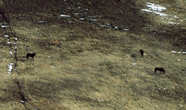
|
|
|
Our Vision: A Two-Part Solution
Part 1: Holding the Bureau of Land Management Accountable The Bureau of Land Management (BLM) should release as many of the more than 55,000 wild horses and burros currently being held in government enclosures as possible. The current incarceration is not only cruel but cost taxpayers ca. $50 million per year. The equids should be placed back on public lands that currently are either totally depopulated of wild horses and burros or support only small, nonviable populations of the animals. These are areas in which horses and burros have roamed for more than 150 years and their ancestors roamed for many millions of years! The BLM and United States Forest Service (USFS) should do this by employing intelligent and humane strategies that are far-seeing in their scope. Through cooperative agreements with other government agencies, corporations, private landowners & water-rights holders, the BLM and USFS should employ sections 4 and 6 of the Wild Free-Roaming Horse and Burro Act to secure complete, year-round & long-term- habitats for populations of wild horses and burros. This would complement public areas that lack critical habitat components.
Both the BLM and USFS should fulfill their original mandate as expressed in the Act. Within the legal wild horse and burro areas, the government must stop carrying out the agenda of the livestock, hunting, energy, mineral, etc. industries, which has been heavily influencing policy since at least 1980. As government agencies serving the American public, the BLM and USFS have an obligation to provide public transparency regarding their actions. The agencies should allow independent inspectors from not-for-profit and other segments of society into holding facilities where wild horses and burros are being kept. Based on the assessments of these independent observers, the government should provide required veterinary care to sick or injured animals. Should the BLM ever feel compelled to hold any more roundups, strong and clear scientific justification should be provided to the American public and all such roundups should be required by law to be monitored by independent observers to ensure that roundup contractors follow stringent humane guidelines. The sad truth is that most roundups are unnecessary, for through the intelligent employment of Reserve Design, vibrant, thriving, long-term-viable, ecologically well-integrated & naturally self-stabilizing populations of wild horses and burros can be realized. This is the true and noble intent of the Wild Free-Roaming Horse and Burro Act, which is still the law of the land. Part 2: Reserve Design as the Alternative Implement a Reserve Design tailored to meet the specific needs of each unique herd and its corresponding Herd Area or Territory. (See Chapter IV of wildlife ecologist Craig C. Downer’s The Wild Horse Conspiracy.) Highlights of Reserve Design include: 1) Carefully study the ecosystem(s) in questions, including both natural components and the human element, and determine where Reserve Design can best work and how it can best be implemented. 2) Incorporate natural barriers wherever possible. 3) Where necessary, construct semipermeable, artificial barriers. 4) Establish buffer zones with the cooperation of local people.
5) Restore natural predators of the wild horses and burros such as pumas, wolves & bears. 6) Allow horses to fill their niche and naturally self-stabilize within the circumscribed but complete and long-term-viable habitats. 7) Develop programs to educate the public about the positive aspects of wild horses and burros, such as the ability of the animals to restore degraded ecosystems, build healthy soils, disperse a wide variety of intact seeds of members of diverse native plant species, help other animals by opening up water and food sources during winter and summer extremes — the list goes on. 8) Develop win-win relationships between wild horse & burro herds and local human communities by providing pay for monitoring & protecting herds and herd access to resources on private and other nonfederal lands, and allowing ecotourism enterprises that would guide people from all over the world to observe these beautiful creatures. 9) Hold field zoology and ecology classes to allow for observation and investigation of wild horses and burros in a respectful and noninvasive way. These classes would be spread out over all areas in which herds live, as would the ecotours, so as not to impact any particular herd overly. |
|

